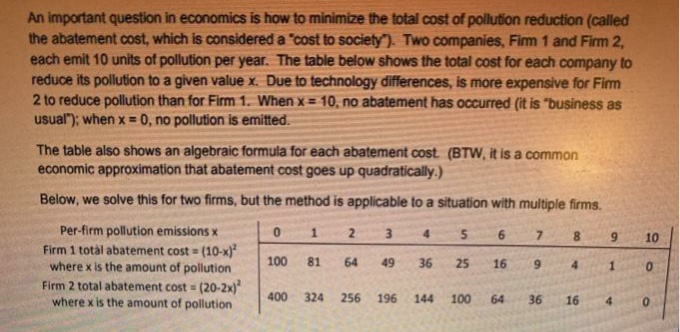b. Can the total abatement cost be lowered by requiring unequal pollution reductions from the Firms, while still maintaining a total pollution reduction of 107 Show the total cost for reductions of 6 ond 4 units, 7 and 3 units, etc., for Firms 1 and 2 respectively
b. Can the total abatement cost be lowered by requiring unequal pollution reductions from the Firms, while still maintaining a total pollution reduction of 107 Show the total cost for reductions of 6 ond 4 units, 7 and 3 units, etc., for Firms 1 and 2 respectively
Microeconomics A Contemporary Intro
10th Edition
ISBN:9781285635101
Author:MCEACHERN
Publisher:MCEACHERN
Chapter17: Externalities And The Environment
Section: Chapter Questions
Problem 5QFR
Related questions
Question

Transcribed Image Text:b. Can the total abatement cost be lowered by requiring unequal pollution reductions from the
Firms, while still maintaining a total pollution reduction of 10? Show the total cost for reductions
of 6 and 4 units, 7 and 3 units, etc., for Firms 1 and 2 respectively.

Transcribed Image Text:An important question in economics is how to minimize the total cost of pollution reduction (called
the abatement cost, which is considered a "cost to society"). Two companies, Fim 1 and Firm 2,
each emit 10 units of pollution per year. The table below shows the total cost for each company to
reduce its pollution to a given value x. Due to technology differences, is more expensive for Fim
2 to reduce pollution than for Firm 1. When x = 10, no abatement has occurred (it is "business as
usual"); when x = 0, no pollution is emitted.
The table also shows an algebraic formula for each abatement cost. (BTW, it is a common
economic approximation that abatement cost goes up quadratically.)
Below, we solve this for two firms, but the method is applicable to a situation with multiple firms.
Per-firm pollution emissions x
Firm 1 total abatement cost = (10-x)
where x is the amount of pollution
Firm 2 total abatement cost = (20-2x)
where x is the amount of pollution
1.
3.
4.
9.
7.
8.
6.
10
100
81
64
49
36
25
16
9.
4.
400
324
256
196
144
100
64
36
16
4.
Expert Solution
This question has been solved!
Explore an expertly crafted, step-by-step solution for a thorough understanding of key concepts.
This is a popular solution!
Trending now
This is a popular solution!
Step by step
Solved in 2 steps

Knowledge Booster
Learn more about
Need a deep-dive on the concept behind this application? Look no further. Learn more about this topic, economics and related others by exploring similar questions and additional content below.Recommended textbooks for you



Economics (MindTap Course List)
Economics
ISBN:
9781337617383
Author:
Roger A. Arnold
Publisher:
Cengage Learning



Economics (MindTap Course List)
Economics
ISBN:
9781337617383
Author:
Roger A. Arnold
Publisher:
Cengage Learning